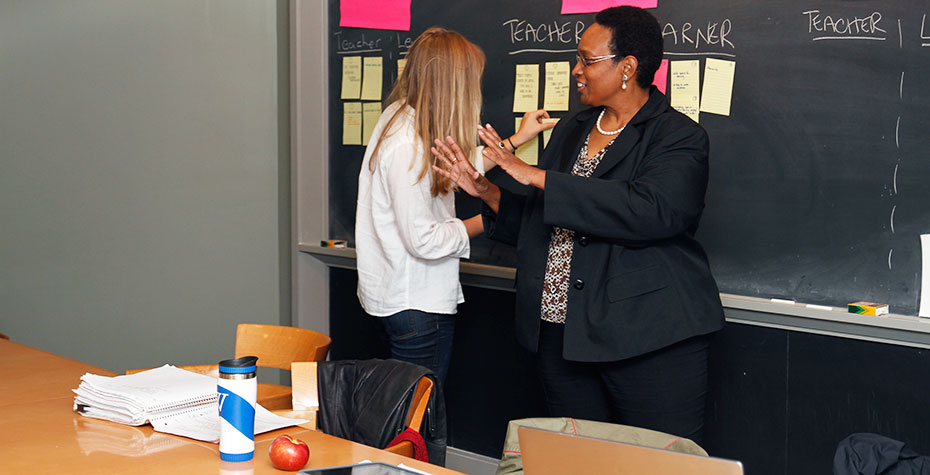Best New Applications for Tech in Teaching? We're Exploring It in EDU/CS 322 Digital Technologies and Learning Communities

As digital technologies become part of our social fabric, more and more educators are asking questions about how to successfully integrate them into the classroom. Robbin Chapman, associate provost, academic director of diversity & inclusion, and lecturer in the Education Department, has created a new interdisciplinary course to support the development of thoughtful and responsive young educators who can address the unique challenges that come with the technology-rich options of today’s learning environments: EDU/CS 322 Digital Technologies and Learning Communities.
In the seminar, Chapman’s goal was to merge the intellectual traditions of the liberal arts with design practices used outside the academy, and thus encourage her students to imagine new technologies for learning. “I love both teaching and learning,” says Chapman, “and especially teaching and learning with Wellesley students.” Chapman engages students in both problem-setting and problem-solving within the context of each student’s individual experience. “My vision was to seed the course with a mix of STEM and humanities perspectives, and have them tackle sticky learning technology issues. Throw in malleable digital technologies, stand back, and watch our students create amazing learning and teaching spaces. I’m captivated by the possibilities,” she says.
During one project, Chapman challenged her class to reimagine how students might learn in public spaces on Wellesley’s iconic campus. One team suggested using augmented reality technologies and interactive wall surfaces to teach diners in Bates Dining Hall computer programming concepts; another sought to recreate Lake Waban as a classroom by employing digital technologies to engage with the underwater life of the lake; still others proposed integrating virtual and physical spaces in the Lulu Chow Wang Campus Center to help students make new friends. Says computer science and economics major Veronica Lin ’15, “The design thinking process, a concept that we constantly discuss and apply in EDUC/CS 322, can truly empower teachers and students to develop creative and innovative solutions to challenging problems, especially those around using technology in education.”
Chapman also integrates the expertise of a group of guest lecturers into her class throughout the semester. Adam van Arsdale, associate professor of anthropology at the College, shared his teaching experience from the first WellesleyX course. Other guests include a visiting scientist from MIT who spoke on participatory learning cultures, an expert on computing innovation from Olin College who discussed interactive learning technologies and “maker spaces.” At the end of the semester, the class will Skype with a representative from IBM Kenya, who will address culturally-based approaches to technology policy.
Chapman encourages her students to think about the rich possibilities that emerge when intentionally considering equity and diversity in relation to education. She helps students recast their perception of technology from an agent of learning to a material or tool that they become agents in employing to imagine, design, and build. Psychology major Becky Hamilton ’15 observes: “One of the things that I enjoy about this course is that my understanding and conceptualization of ‘technology’ changes from class to class. I used to think that technologies had to be electronic and complicated; now, I realize that the word technology encompasses everything from a paperback book to a piece of playground equipment to an MRI machine at a hospital. We just started in-class presentations of our final projects, and it's fascinating to see what each person has designed and realize that everyone's definition of ‘learning technology’ is a little bit different.”
Lin too finds her thinking about technology has expanded. “I've been particularly interested in how we can better design technology to enhance the world of education, but this course has taught me how to use what's out there already.” She adds, "The design thinking process, a concept that we constantly discuss and apply in EDUC/CS 322, can truly empower teachers and students to develop creative and innovative solutions to challenging problems.”
Throughout it all, Chapman coaches students to be fearless in trying new things. As the end of the semester approaches, she says, “I want to thank my students for their hard work and risk taking. I can’t wait to teach this class again!”
Spotlight on Teaching is an ongoing series introducing inspiring and innovative teachers and courses at Wellesley.
